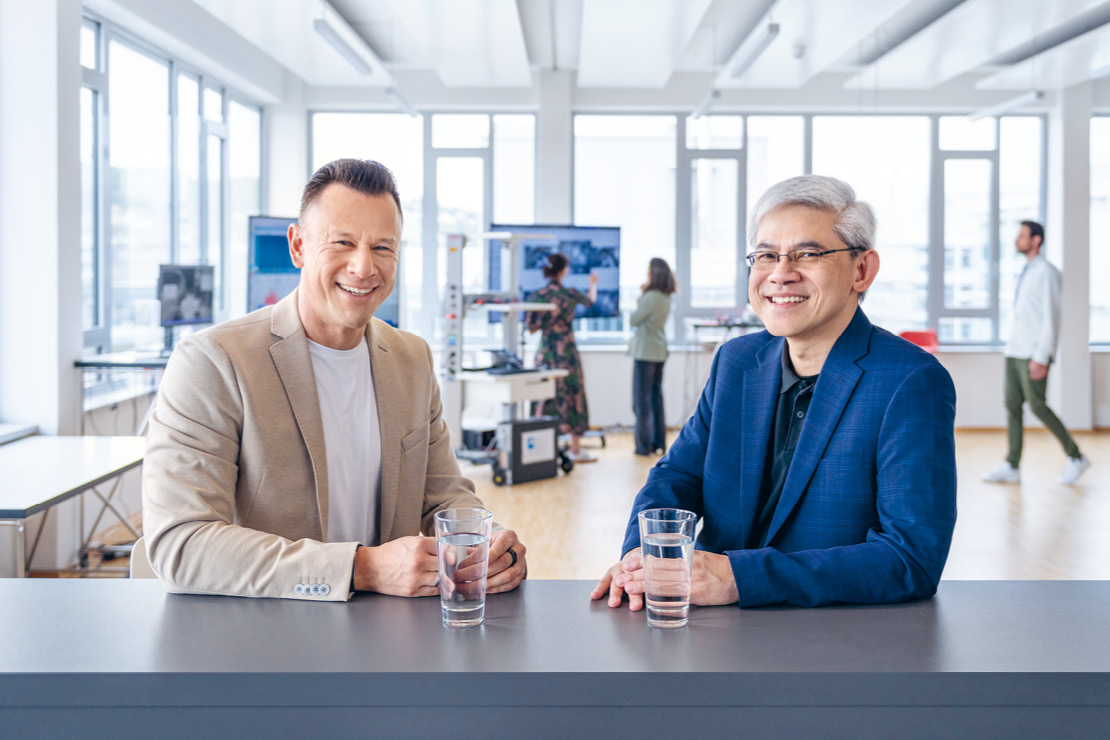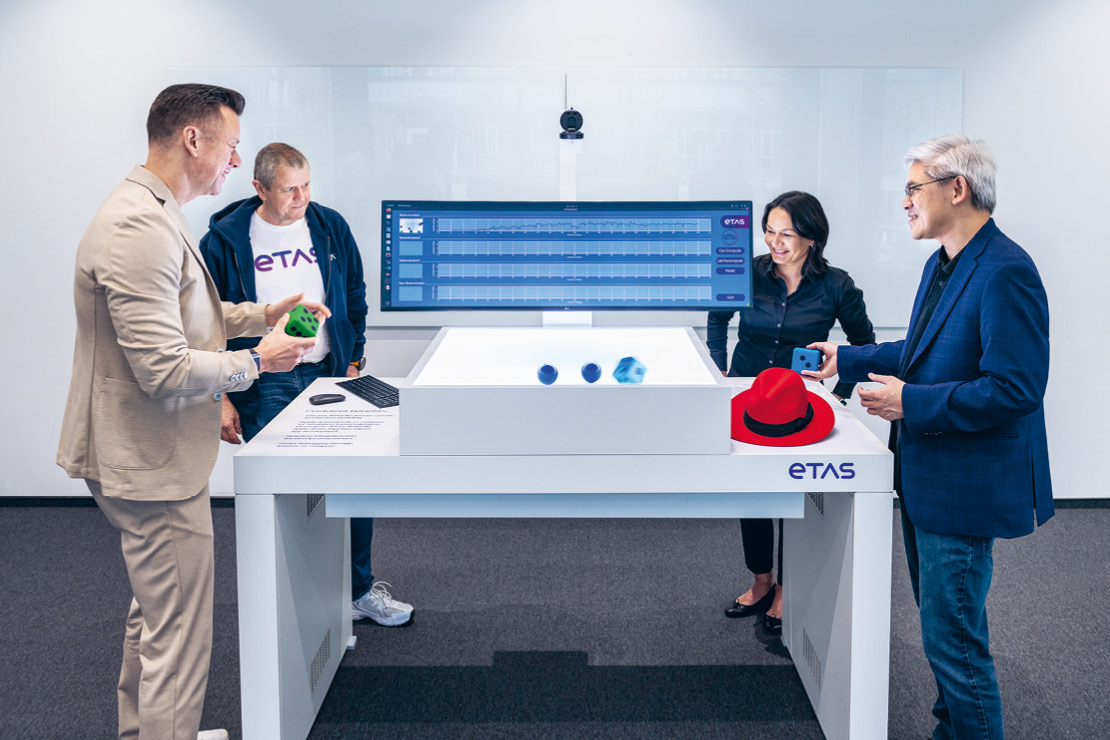
ETAS GmbH & Red Hat
customer experience In dialog with Dr. Thomas Irawan + Francis Chow
As Vice President and General Manager, Francis Chow is responsible for the in-vehicle operating system and edge computing businesses at Red Hat. Dr. Thomas Irawan is President and Chairman of the Board of Management at ETAS GmbH, a specialist for the development and operation of automotive software, a wholly owned subsidiary of Robert Bosch GmbH.
Thomas Irawan: There has been a lot of hype around the capabilities of SDVs, such as autonomous driving, seamless connectivity, and constant over-the-air updates. However, it seems that we are going through a phase of disillusionment. I think this can be attributed to the recognition that the necessary transformation has a more profound impact on the organization and culture of companies and their relationships with each other than expected.
Francis Chow: Yes, the main challenge is that OEMs’ and suppliers’ organizations and processes are too hardware-focused for SDV development. They’re built around traditional manufacturing, which clashes with the fast-paced, iterative nature of software creation. Effective SDV development requires agile practices, continuous integration, and a culture of ongoing innovation, contrasting with the linear approach of hardware development.
Thomas Irawan: In German we call this »lastenheftgetriebene Entwicklung« – providing thousands of pages of requirements and detailed specifications to all the suppliers and then expecting a 100% working result just before the SOP of the vehicle. This hinders fast innovation cycles. OEMs typically procure electronic control units (ECUs) with pre-integrated software from a single supplier. These ECUs are part of a complex electrical system within the vehicle. And as a consequence, ECUs from different suppliers complicate inter-ECU communication, integration, and cause compatibility issues, resulting in longer development times and higher costs.
Francis Chow: And when challenger OEMs arrived in the SDV market, they caused a paradigm shift by focusing on innovation through software instead of hardware. Their decoupled software and hardware approach paved the way for continuous development and deployment, resulting in much shorter development time and lower development cost.
Western vehicle manufacturers are hiking prices for advanced vehicles due to costly and complex developments.
Francis Chow
Thomas Irawan: But some OEMs try to control the entire development process, aiming to own the whole software stack from the ECU’s OS to applications. They’re pushing for more in-house production to cut supplier dependence. Additionally, they focus on full features upfront instead of starting with an MVP. This results in expensive initial investments and legacy challenges.
Francis Chow: As a consequence, these OEMs stretched thin regarding capabilities, resources, budget, and time-to-market trying to support all the non-differentiating software components, along with the customer facing differentiating software that would actually add unique value.
Thomas Irawan: And in this way proprietary solutions are created that do not scale, as the ecosystem even of large OEMs is relatively small, compared e.g., to the smartphone ecosystems with billions of users. More importantly, this means that automakers are cutting themselves off from the innovation paths that could emerge through cross-company and cross-industry collaboration.
Francis Chow: We are already seeing the effects of this in the market. Chinese automakers are challenging Western and Japanese OEMs as their cars now compete globally with established brands, particularly in electric vehicles, offering lower prices and more innovative features. They are obsessed with user experience and follow a »feature first« mentality, delivering what their customers really want. Meanwhile, Western vehicle manufacturers are hiking prices for advanced vehicles due to costly and complex developments.
Thomas Irawan: Some Chinese OEMs outperform Western manufacturers because they use available software for non-differentiating parts and try not to own it, instead they focus on differentiating software, e.g., infotainment apps, and thus are able to innovate in much faster cycles.
More importantly, this means that automakers are cutting themselves off from the innovation paths that could emerge through cross-company and cross-industry collaboration.
Thomas Irawan
Francis Chow: In other words, to remain competitive, vehicle manufacturers should focus on differentiating elements like app development to free up resources, budget and speed up time-to-market of innovative software functions. By partnering with ecosystem allies such as Red Hat and ETAS for ECU operating systems and middleware, the industry can foster accelerated innovation and reduce costs through standardized infrastructure.
Thomas Irawan: I would like to express this with a more general appeal: You cannot survive the transformation on your own! You need to collaborate and integrate! Some OEMs and Tiers may need to change how they work with suppliers in general, i.e., moving from transactional supplier models to integrated automotive partnerships that involve knowledge sharing and joint development.
Francis Chow: That naturally brings us to the topic of open source software (OSS). Open source projects have long proven their potential to set industry standards, ensuring compatibility and interoperability between different systems and components, as well as across different suppliers and manufacturers. An excellent example is Linux – it has become the de facto standard of computer servers and is being deployed to support mission critical applications across many industries including airlines, banks, healthcare providers and more. This OSS model has proven the outstanding value it has created, and we can bring this model more broadly to the automotive industry.
Thomas Irawan: Further, new automotive-specific OSS approaches are very promising, e.g., the Eclipse SDV Working Group, where ETAS was one of the founding members. Alongside platform and middleware communities, initiatives like COVESA focus on data and services, while SOAFEE aims to standardize cloud-native architecture down to the chipset level.
The future of software-defined vehicles shines with promise, and through open industrial collaboration, we have the power to accelerate this vision into reality!
Thomas Irawan
Francis Chow: So far, we have very much focused on the in-vehicle part. But digital transformation turns vehicles from standalone systems into network nodes. Collaboration between OEMs, Tier suppliers, tech companies and service providers is essential for creating an ecosystem where vehicles can operate seamlessly within a larger network of connected devices and services. And for successful implementation of SDVs, OEMs and Tier suppliers must adopt a holistic view that encompasses the broader technological ecosystem, including edge computing and cloud infrastructure.
Thomas Irawan: One area in which the importance of the holistic approach is immediately apparent is cyber security. As vehicles become more connected, they also become more vulnerable to cyber threats. A comprehensive security strategy must include protection across all layers of the technology stack, from in-vehicle systems to cloud-based services.
Francis Chow: Absolutely. Safety without security means no safety. And there are many other important aspects, just think of advanced driver-assistance systems (ADAS) and autonomous driving (AD). Here, vehicles are already generating vast amounts of data from sensors, cameras, and other devices. Efficiently managing this data requires a seamless flow from the vehicle to edge nodes for local processing and quick decision-making and to the cloud for storage, further analysis, and insights, now driven more and more by AI-enabled technologies.
Thomas Irawan: Through our work on next-generation ADAS /AD function development, we have realized that a significant portion of developers’ efforts was dedicated to finding out why things actually did not work as intended. We needed a way to ensure that a system would operate predictably within the unpredictable and highly dynamic conditions of the real world. Our deterministic middleware solution is designed to tackle this very challenging issue. Scenarios that previously took us days to replicate – and sometimes we couldn’t replicate them at all – are now just minutes away from being loaded into a development environment. This allows developers to easily debug and resolve issues and there-by to speed up the development of ADAS/AD functions.
We combine the best of both worlds – Red Hat’s software infrastructure skills and ETAS’s automotive knowledge – and deliver state-of-the-art capabilities for software-defined vehicles that mirror advances at the enterprise edge.
Francis Chow
Francis Chow: This is where Red Hat’s expertise can play a role in helping advance the SDV vision. As discussed, many traditional systems and design methodologies have come with high development costs, slow time-to-market and difficulty in addressing new customer demands while retaining critical safety checks. To help address these challenges, Red Hat is building the Red Hat In-Vehicle Operating System, intended to serve as a functionally safe, automotive-specific Linux operating system foundation.
Thomas Irawan: I was immediately impressed by Red Hat’s strategy to push automation limits and enhance the developer experience and felt confident in its potential for success. For our ETAS deterministic middleware, it is essential that the underlying operating system provides dependable safety features. They allow us to broaden the range of automotive applications we can address. This approach greatly simplifies the creation of safety-critical functions and accelerates development exponentially…
Francis Chow: … and at the same time, our joint solution shows how much added value cross-industry collaboration brings. We combine the best of both worlds – Red Hat’s software infrastructure skills and ETAS’s automotive knowledge – and deliver state-of-the-art capabilities for software-defined vehicles that mirror advances at the enterprise edge.
Thomas Irawan: Right, we talked a lot about technology, but what about business models?
Francis Chow: I believe automakers need to re-think their business strategy. We need to transition from a world where automakers strive to minimize the cost of production per vehicle and maximize the revenue at the time of sale of the vehicles, to a world where they need to optimize the time-to-market for market share growth and maximize the revenue through the lifecycle of the vehicles. Procurement departments need to understand this, or they will likely drive software companies away to work with those automakers who really understand this paradigm change and gain a head start.
Thomas Irawan: How does this business model change tie back to our conversation about open source?
Francis Chow: Well Thomas, I am glad you asked. The SDV business model requires speed, agility, and focus. Open source is a key enabler for all three success factors. First, it gives automakers speed of development and innovation with a common platform and toolchains from vehicle to cloud, leveraging open collaboration for accelerated feature development and bug fixing. Second, the DevOps approach of continuous integration and delivery with the capability of frequent and seamless update allows for agility. Third, by using open source for non-differentiating technology layers, automakers can really focus on building the most differentiating applications and driving experience.
Thomas Irawan: I couldn’t agree more. The future of software-defined vehicles shines with promise, and through open industrial collaboration, we have the power to accelerate this vision into reality! And I believe I speak for both of us when I say that we want to encourage the industry stakeholders to take a decisive step forward: join an open source working group, engage with the community, and explore how open source can contribute to the transformation of the automotive industry!


